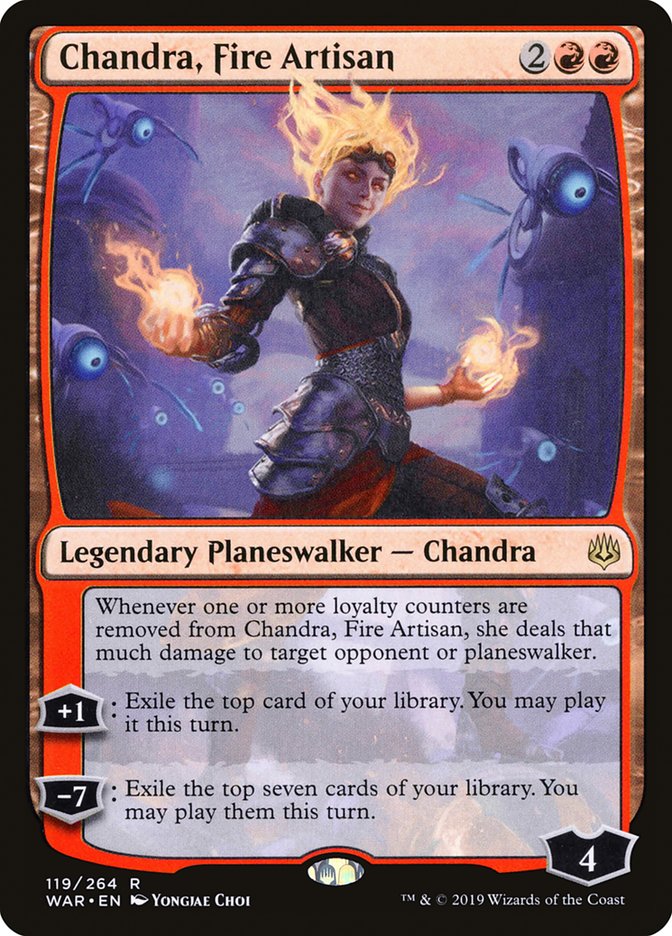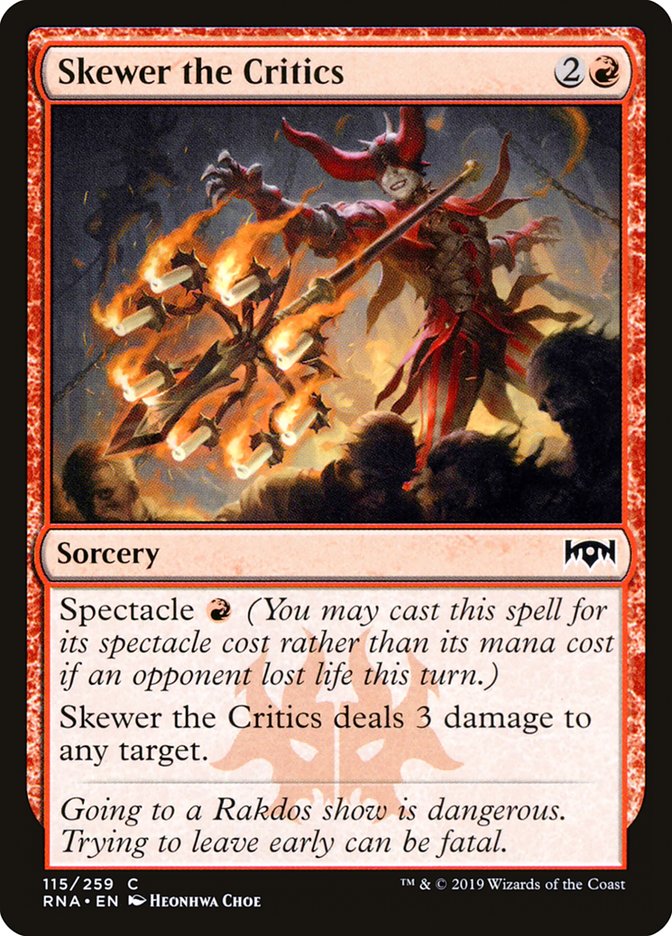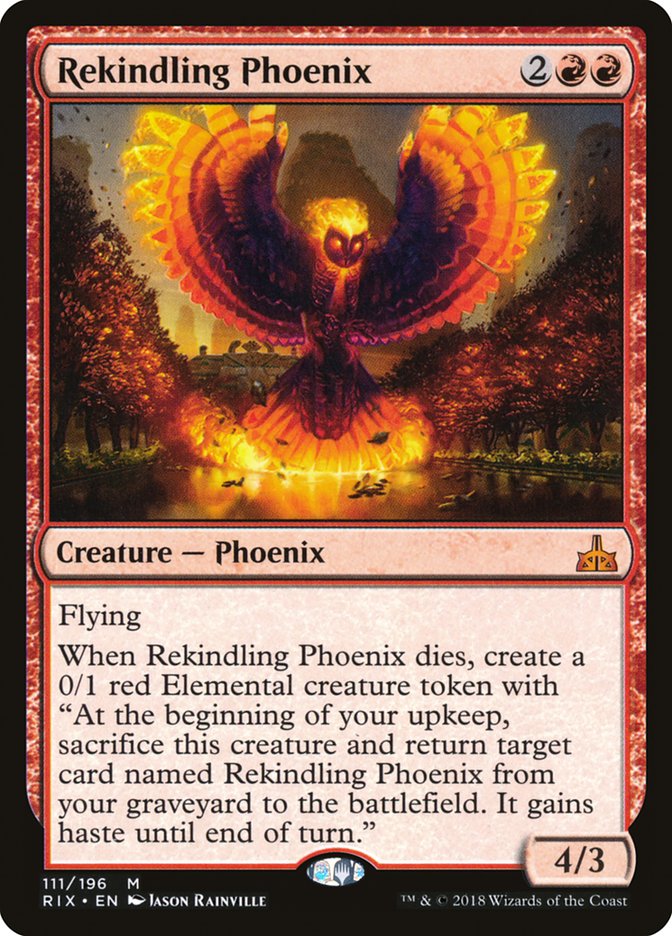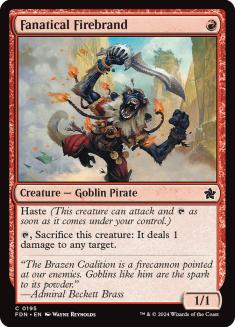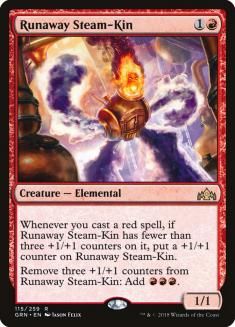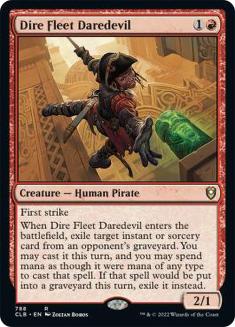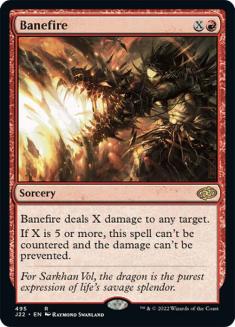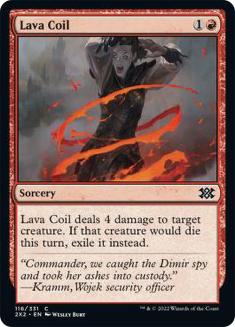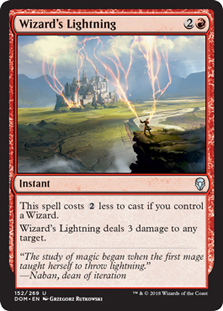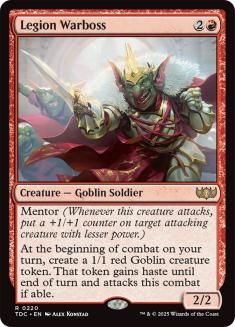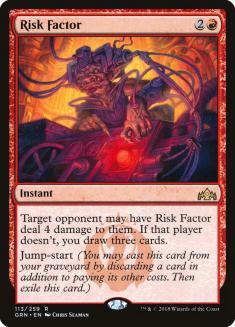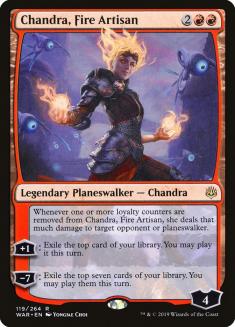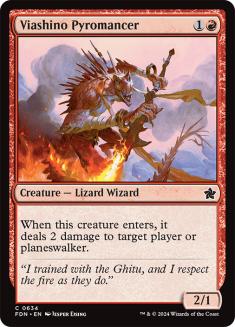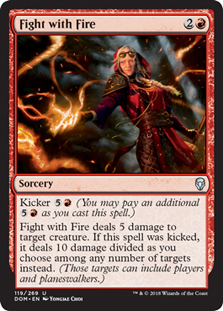It seems like every opening of a new Standard format is won by the most consistent, aggressive strategy in the game, Mono-Red: a little bit of burn, cheap creatures, and perhaps a three- or four-drop that helps seal the deal. We’ve seen this in the past with the likes of Goblin Rabblemaster, but time and time again it’s the same old thing.
Whenever a new set comes out, people are a bit weaker to linear, consistent strategies. When you’re a multicolor deck, your manabase isn’t always pristine, which ultimately results in a few losses because you took too much damage, drew the wrong colors, or too many lands entered the battlefield tapped. It happens, and these linear, monocolored aggressive decks will punish you greatly.
That isn’t to say that Mono-Red is always the best choice, but it is almost always a fine choice in the first week of any Standard format, as the spells do mostly the same stuff (two- or three-damage burn spells, cheap creatures). And when it comes to condensing the game, that will almost always benefit the most consistent deck.
Creatures (20)
- 4 Fanatical Firebrand
- 4 Ghitu Lavarunner
- 4 Goblin Chainwhirler
- 4 Viashino Pyromancer
- 4 Runaway Steam-Kin
Planeswalkers (4)
Lands (20)
- 20 Mountain
Spells (16)

Will Pulliam’s list from this weekend did a lot of things right.
Almost every Mono-Red deck over the last six months or so has put an emphasis on Experimental Frenzy, and for good reason. It’s a great form of card advantage that ultimately buries your opponent if left unfettered for long enough. However, with the reprinting of Mortify, control decks got a powerful tool to interact with both creatures and your premier form of card advantage. And if your entire draw revolves around Experimental Frenzy, a single counterspell or Mortify can take the wind right out of your sails.
Cards like Bedevil and Vraska’s Contempt aren’t being played in high numbers right now, and stuff like Despark and Ixalan’s Binding doesn’t quite cut it against a deck full of cheap threats and burn spells. With that in mind, playing Chandra, Fire Artisan as your top-end for a deck full of cheap threats is perfect. It punishes your opponent for attacking it, generates card advantage, and virtually ends the game once you hit ultimate status. That’s a pretty good deal for a four-mana planeswalker.
Most decks over the last few months have also adapted themselves to fend off Experimental Frenzy. Maindeck answers like Knight of Autumn and Thrashing Brontodon were common. White decks moved to three or four copies of Conclave Tribunal as their primary source of removal. And even though Experimental Frenzy is a great card, it’s often inconsistent, leading to some lame-duck games. And while Chandra, Fire Artisan can just pull off a few lands from the top, it’s still threatening an ultimate, and you still get to cast the cards in your hand.
In a lot of matchups, these two cards will be functionally similar. If left unchecked, they should each win the game on their own, so long as you don’t hit a glut of lands along the way. And because of that, we need to examine the answers that hit one and not the other. And as of right now, Mortify seeing so much play means we need to play Chandra, Fire Artisan until that shifts.
Now, before we go any further, I’ve been playing quite a bit with Mono-Red Aggro on Magic Arena this week in preparation for an MCQ this weekend. My results haven’t been stellar, but they’ve been far above average. The deck is powerful, consistent, and can certainly play a long game thanks to Light Up the Stage and Chandra, Fire Artisan. Let’s take a look at my current list and go over the most popular matchups in Standard.
Creatures (20)
- 4 Fanatical Firebrand
- 4 Ghitu Lavarunner
- 4 Goblin Chainwhirler
- 4 Viashino Pyromancer
- 4 Runaway Steam-Kin
Planeswalkers (4)
Lands (20)
- 20 Mountain
Spells (16)
Sideboard

Now, before we go any further, let’s take a look at what’s missing.
I hate this card. I absolutely despise burn spells that don’t work well with your attacking creatures. This card is Lava Spike. This is one of the least consistent, most frustrating burn spells you can draw in spots where you desperately need to kill a blocker.
With eight Wizards in the deck, it shouldn’t be too difficult to turn on Wizard’s Lightning. The fact that it costs one mana in a lot of spots gives you a cheap way to clear a blocker while also dealing enough damage to close games when it comes down to the wire. To me, there is no question: you shouldn’t be playing Skewer the Critics. Max out on Wizard’s Lightning instead.
I’m sure this one is puzzling to some. In my experience, the way you beat decks that Rekindling Phoenix is good against is by making sure you can cast all of your spells at all times. I often get stuck with four-mana spells in my hand, even when I just have four of them in my deck. When you add more, you’re often incentivized to play an extra land in the sideboard or keep more risky hands that contain four lands. I don’t want to do either of those things, so I don’t want to play more than four cards costing more than three mana.
We have plenty of standalone threats and powerful tools that cost three mana. Let’s utilize them as best we can so we can keep our curve low. Ultimately, keeping your curve low gives you the ability to cast all of the spells you draw in a given game. When I lose games with Mono-Red, it is usually to one of these two scenarios:
1) Stuck on one or two lands, unable to cast all the spells in your hand before your opponent gains control of the battlefield.
2) Opponent casts some card(s) that you just can’t beat in a million years or require too many resources to kill. This is somewhat alleviated by playing Lava Coil and Fight with Fire in the sideboard, as they contain some of the more irksome creatures your opponent.
Now, with that out of the way, let’s get to the most popular matchups in the format, and how I think you should sideboard against them (and why!).
Mono-Red
Creatures (20)
- 4 Fanatical Firebrand
- 4 Ghitu Lavarunner
- 4 Goblin Chainwhirler
- 4 Viashino Pyromancer
- 4 Runaway Steam-Kin
Planeswalkers (4)
Lands (20)
- 20 Mountain
Spells (16)

Out:
In:
For me, this matchup is all about casting and protecting your four-mana spell. And with both players having access to a ton of removal after sideboard, you want to make sure you’re able to protect your Chandra, Fire Artisan if you draw it first.
You also want to minimize the number of creatures you play that are vulnerable to Goblin Chainwhirler. But with that said, I do think Viashino Pyromancer is just too good to cut. It’s like a Shock to the dome that also requires an answer, or an opposing Goblin Chainwhirler.
For the most part, I don’t cast Goblin Chainwhirler unless I’m killing a creature from my opponent or desperately need to check theirs. The latter scenario is rare, but I do recommend playing the matchup a bit for yourself to help formulate the ideas necessary to make your own decisions based on the given circumstances. There are no sacred cows. There are only rough guidelines.
Esper Control
Planeswalkers (7)
Lands (26)
Spells (27)

Out:
In:
You want threats in this matchup more than burn spells, but a healthy amount of burn is still okay. At some point, you might want to stop casting creatures so your opponent can’t gain any more life. In those scenarios, cards like Vraska’s Contempt and Moment of Craving offer your opponent a bit of breathing room. They come few and far between, but it does come up more than you might think. And the main problem here is that Absorb is still super-annoying.
If your Esper Control opponent wants to win this matchup, they can do so pretty easily. Sideboard cards like Basilica Bell-Haunt and Enter the God-Eternals can do some serious damage, but more often than not it’s going to come down to how low their deck’s curve actually is.
The reason we sideboard out Runaway Steam-Kin is because it’s the worst threat in the deck by a lot. It doesn’t get better unless you spew your hand, which ultimately ends up running you into a big sweeper effect. We need most of our threats to be good on their own. Runaway Steam-Kin is also a really bad topdeck, as a 1/1 for two mana is just terrible. And while Goblin Chainwhirler isn’t exactly ideal, it survives both Cry of the Carnarium (which is growing in popularity) and Moment of Craving, while occasionally dealing the last point of damage to Teferi, Hero of Dominaria or Teferi, Time Raveler.
Of every major deck in the format, Esper Control is likely the worst matchup for Mono-Red, if only because they have so many tools that virtually invalidate your burn spell plan, as well as a ton of removal for your threats. That combination is pretty tough to beat, especially if you don’t have a hyper-aggressive start. You regularly win games on the play where you curve out, but will often lose those same games on the draw because your opponent has the sweeper at the right time, or just an extra turn to start casting removal before taking huge chunks of damage.
They also have Absorb, which completely alters the face of the matchup. Counterspells are usually bad, but not here. Absorb effectively counters two spells, as you’re likely throwing Lightning Strike at their head.
Simic Nexus
Planeswalkers (3)
Lands (25)
Spells (32)
- 4 Opt
- 4 Search for Azcanta
- 1 Blink of an Eye
- 4 Nexus of Fate
- 4 Root Snare
- 2 Sinister Sabotage
- 4 Chemister's Insight
- 4 Growth Spiral
- 4 Wilderness Reclamation
- 1 Callous Dismissal
Sideboard

Out:
In:
This matchup is all about racing. They don’t have much interaction, so you don’t need your cards that help you go super-long. That’s why we’re cutting Chandra, Fire Artisan. If the game goes long enough for Chandra, Fire Artisan to have a major impact, you’ve likely already lost. I only leave in Light Up the Stage because it’s so cheap and will almost always be turned on in the early turns of the game, ideally allowing you to play your entire hand.
You need to spew the battlefield and hope they have to start casting Nexus of Fate or Root Snare before they get set up, and then you need to just hope they don’t get everything together before you throw a lethal burn spell at their dome. Mulligan hands without an early creature to cast, though on the play a Viashino Pyromancer is probably fine. One-drop-heavy hands are better than anything else, as you just want to put them under as much pressure as possible.
If they go for a sideboard plan featuring creatures, you should be fine. The easiest way for you to lose is if they take too many turns in a row, as you can handle a 3/3 Biogenic Ooze without trouble. Even Carnage Tyrant gets blocked pretty easily in a pinch, because they don’t really have removal in their deck.
White Aggro
Creatures (29)
- 4 Adanto Vanguard
- 4 Skymarcher Aspirant
- 4 Snubhorn Sentry
- 4 Benalish Marshal
- 4 Dauntless Bodyguard
- 4 Venerated Loxodon
- 2 Tithe Taker
- 3 Law-Rune Enforcer
Lands (20)
- 20 Plains
Spells (11)

Out:
In:
Not a whole lot of sideboarding to be done here. Most games come down to whether or not you draw enough removal to contain Legion’s Landing. On occasion, they’ll run you over with Venerated Loxodon, but I think you should be favored in most cases. History of Benalia is a pretty big deal, but you can contain it pretty easily. It just takes two resources.
If you get a Chandra, Fire Artisan going, or even a Light Up the Stage, you should be able to bury them in card advantage. Goblin Chainwhirler is just such a huge spell against them that they don’t have many ways to beat. With that said, they now get to play another one-drop creature with more than one toughness, which means Goblin Chainwhirler will lose just a little bit of value, but it’s still insanely good.
You want to cut Viashino Pyromancer here because it doesn’t affect the battlefield much. Its body is outclassed by your opponent’s creatures pretty easily, or gets blocked and trades down on mana. You also win the game by attacking with creatures while clearing their blockers, which means the direct damage to their face is less valuable than in other matchups. The same goes for matchups like Sultai Midrange, where getting ahead on the battlefield is much more important than dealing a few points of damage.
Some people like cutting Fanatical Firebrand in this matchup, but I’m all about clearing out those small creatures to make sure you can keep Legion’s Landing in check. If they ever get to transform it, things will go south in a hurry.
Bant Midrange
Creatures (29)
- 4 Llanowar Elves
- 2 Shalai, Voice of Plenty
- 2 Knight of Autumn
- 2 Deputy of Detention
- 4 Hydroid Krasis
- 4 Growth-Chamber Guardian
- 4 Frilled Mystic
- 4 Incubation Druid
- 3 God-Eternal Oketra
Planeswalkers (7)
Lands (24)

Out:
In:
Obviously things are getting a bit murky here, but I think cutting some of your weaker creatures to contain the battlefield is key. Fight with Fire and Lava Coil are exceptional, clearing many of the opponent’s larger creatures, but the hard truth is that the game will mostly be decided by whether or not your opponent sticks a God-Eternal Oketra. That card will close the game quickly, so your main plan should be to slow them down by knocking out their mana creatures.
You should be mostly favored here, as your threats won’t be dying much and your nut draws are nigh-unstoppable. Without traditional removal, as well as a slew of mediocre speed-bumps along the way, you should be fine so long as you draw a healthy mix of lands and spells.
I haven’t played against this matchup a ton, but I’ll tell you this: draws where you only draw removal won’t go the way you think. You need a creature or two on the battlefield before you start killing stuff so that you can apply pressure to their life total while killing those threats. You need a foothold to really punish them, or else they’ll eventually just find one of their giant creatures and leave you with a handful of Shocks and the like.
Esper Midrange
Creatures (11)
Planeswalkers (9)
- 3 Teferi, Hero of Dominaria
- 2 Liliana, Dreadhorde General
- 3 Teferi, Time Raveler
- 1 Sorin, Vengeful Bloodlord
Lands (26)
Spells (14)

Out:
In:
Chances are they’re not leaving in Thief of Sanity, so having stuff like Shock is a bit worse than normal. With that said, if they have both Thief of Sanity and Hero of Precinct One in their deck after sideboard, feel free to bring the Shocks back in. Regardless, this matchup can be tough, but you can also win a lot of games in landslide fashion.
They don’t have a lot of ways to beat Chandra, Fire Artisan, nor do they have a lot of cheap removal. That means you can go under them in the first game with cheap threats, or potentially bury them with a Chandra if they spend all their time and energy fighting off your early threats. It’s virtually impossible for them to get a foothold on the battlefield because most of their creatures die to your cheap burn. So their way to get on the battlefield is with planeswalkers, which you can pressure quite easily.
Dovin’s Veto is okay against you, but the trick is finding ways to make them tap out so that it’s less of a threat. Enter the God-Eternals is a nightmare when it connects and might be a reason to potentially side in some number of Lava Coils, but I haven’t found that overly necessary just yet.
Since they don’t have sweepers or great blockers, I like to bring in Legion Warboss to steal the game. If you’re on the play and they don’t hit you with a Thought Erasure, Legion Warboss is the perfect follow-up to an early removal spell. And if they don’t kill it immediately, which could potentially throw them off-curve, it’s sure to compound the damage dealt by your removal spells clearing out their blockers.
Red Dead Redemption
There are quite a few decks in Standard right now that we didn’t quite have time to get to, but I think this will be a fine start. The first few weeks of Standard are always volatile, and I’m assuming that there will be a new “best deck” by next week. After all, decks like Mono-Red Aggro are at the mercy of the opponent on occasion and how much they really want to focus on them. After all, every sideboard slot you dedicate to a red deck means you’re losing some amount of percentage points to a midrange or control opponent, as the types of cards that are great against red are rarely good against anything else.
The more popular Mono-Red Aggro becomes, the worse it will eventually be in the metagame, but that doesn’t mean it’s going to be bad for this weekend. I’ve been winning with the deck quite a lot, and loving every minute of it! Chandra, Fire Artisan is a great addition to the deck, and I’m loving my sideboard and my plans for each matchup. Should I have played Mono-Red Aggro at the Open instead of Temur Reclamation? If I wanted to win, then yeah. That seems like a no-brainer.
This weekend, I’ll be playing in an MCQ, either on Magic Online or in real life. Mono-Red Aggro is my top choice for now, but there’s a good chance I audible to Bant Midrange. It was so good on VS Live! this past Tuesday that I don’t know if I can ignore it.
Regardless of what you choose this weekend, just know that Mono-Red Aggro will be one of the most popular archetypes, and you need to be prepared to beat it. And if you’re not, then don’t be surprised when you catch the wrong end of a Wizard’s Lightning.


